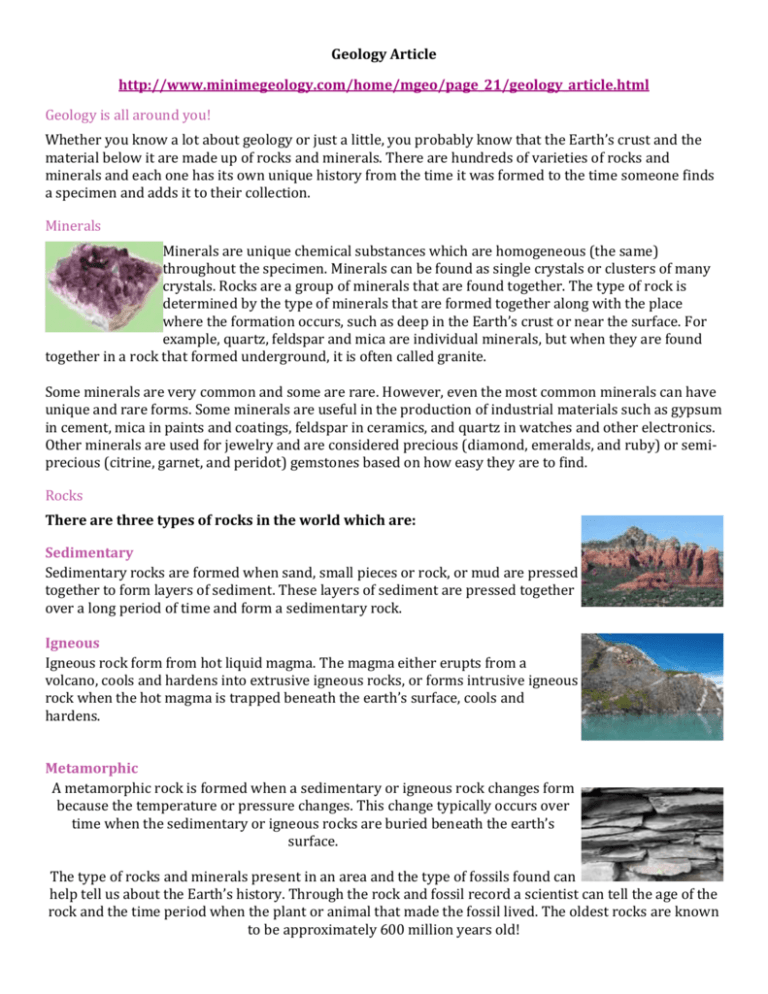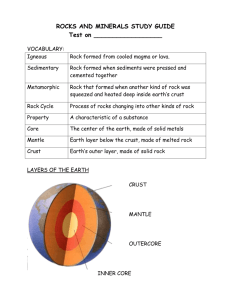Geology Article http://www.minimegeology.com/home/mgeo
advertisement

Geology Article http://www.minimegeology.com/home/mgeo/page_21/geology_article.html Geology is all around you! Whether you know a lot about geology or just a little, you probably know that the Earth’s crust and the material below it are made up of rocks and minerals. There are hundreds of varieties of rocks and minerals and each one has its own unique history from the time it was formed to the time someone finds a specimen and adds it to their collection. Minerals Minerals are unique chemical substances which are homogeneous (the same) throughout the specimen. Minerals can be found as single crystals or clusters of many crystals. Rocks are a group of minerals that are found together. The type of rock is determined by the type of minerals that are formed together along with the place where the formation occurs, such as deep in the Earth’s crust or near the surface. For example, quartz, feldspar and mica are individual minerals, but when they are found together in a rock that formed underground, it is often called granite. Some minerals are very common and some are rare. However, even the most common minerals can have unique and rare forms. Some minerals are useful in the production of industrial materials such as gypsum in cement, mica in paints and coatings, feldspar in ceramics, and quartz in watches and other electronics. Other minerals are used for jewelry and are considered precious (diamond, emeralds, and ruby) or semiprecious (citrine, garnet, and peridot) gemstones based on how easy they are to find. Rocks There are three types of rocks in the world which are: Sedimentary Sedimentary rocks are formed when sand, small pieces or rock, or mud are pressed together to form layers of sediment. These layers of sediment are pressed together over a long period of time and form a sedimentary rock. Igneous Igneous rock form from hot liquid magma. The magma either erupts from a volcano, cools and hardens into extrusive igneous rocks, or forms intrusive igneous rock when the hot magma is trapped beneath the earth’s surface, cools and hardens. Metamorphic A metamorphic rock is formed when a sedimentary or igneous rock changes form because the temperature or pressure changes. This change typically occurs over time when the sedimentary or igneous rocks are buried beneath the earth’s surface. The type of rocks and minerals present in an area and the type of fossils found can help tell us about the Earth’s history. Through the rock and fossil record a scientist can tell the age of the rock and the time period when the plant or animal that made the fossil lived. The oldest rocks are known to be approximately 600 million years old! Geology Article Questions 1. Describe the composition of Earth’s crust. 2. What are minerals? 3. What is the relationship between rocks and minerals? 4. How are rock types determined? 5. List at least 4 examples of minerals. 6. Describe 2 ways in which minerals are used. 7. What are the 3 types of rocks? 8. Using detail, explain how sedimentary rocks are formed? 9. Using detail, explain how igneous rocks are formed? 10. What has to be applied to either igneous or sedimentary rocks in order for metamorphic rocks to form? 11. For what reason(s) are rocks important for Geologists to study? Use 3-5 sentences to answer this question.







